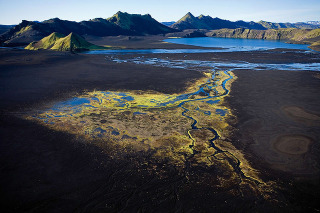Yesterday, national energy company Landsvirkjun received the first loan for its planned Búðarháls dam in Tungnaá River (south Iceland, north-east of Þjórsá river). The 8,6 billion ISK loan comes from the Nordic Investment Bank (NIB) and is dependent on the outcome of the referendum about the so-called IceSave bill, which will take place on April 9th. The energy is meant for Rio Tinto- Alcan’s increased aluminium production.
In February this year Iceland’s parliament voted in favor of a bill that would repay Britain and the Netherlands for money lost when the Landsbanki bank collapsed along with its high interest IceSave accounts in the two countries. The bill is the third one agreed upon by parliament since the collapse of Iceland’s three major banks in the fall of 2008, and the second one to be rejected by Iceland’s president but in March 2010 the majority of voters voted against the bill as it was at that time. The discourse on the IceSave topic seems to be never-ending and has split people into two fighting arrays: Firstly those who claim Icelanders are in no way responsible to pay the debts of a then privatized bank; secondly those who fear Iceland’s political status if the debts will not be paid at all.
In a press release from Landsvirkjun, the company’s director Hörður Árnason says that the loan is an important step in the plans for Búðaráls dam and that it reflects a high trust towards the company. But in fact, the loan – that accommodates one third of the needed amount – is dependent on other loans needed for the construction of the dam, which in other means that for the dam to be built Iceland has to pay the IceSave bill. The European Investment Bank has e.g. repeatedly delayed deciding upon a loan to Landsvirkjun while the IceSave contention is still not solved.
During a discussion in parliament today, prime minister Jóhanna Sigurðardóttir embraced the NIB loan but reaffirmed what she said to be the need to pay the IceSave debts. She also said that parliament members should not interfere with Landsvirkjun about where the company decides to harness energy. The government is, along with the labor market, working on increasing investment opportunities and building up the economy, Sigurðardóttir said.
The damming of Tungnaá river is supposed to produce c.a. 80 MW, which are meant for Rio Tinto-Alcan’s increased production in its aluminium smelter in Straumsvík, Hafnarfjörður.
Landsvirkjun’s original intentions were to channel Skaftá river to Tungnaá river, through lake Langisjór – a extraordinarily beautiful lake at the western edge of Vatnajökull – which would effectively become a reservoir. The Skaftá dam (Skaftáveita) would add another 7 km2 to the lake-reservoir with the purpose to increase the energy capacity of the planned dams in the Þjórsá and Tungnaá rivers. Effectively, the damming would lead to a sediment build-up and increased turbidity which would destroy the lake ecosystem. In February this year environmental minister Svandís Svavarsdóttir announced the preservation of Langisjór, meaning the end of these energy fantasies.
